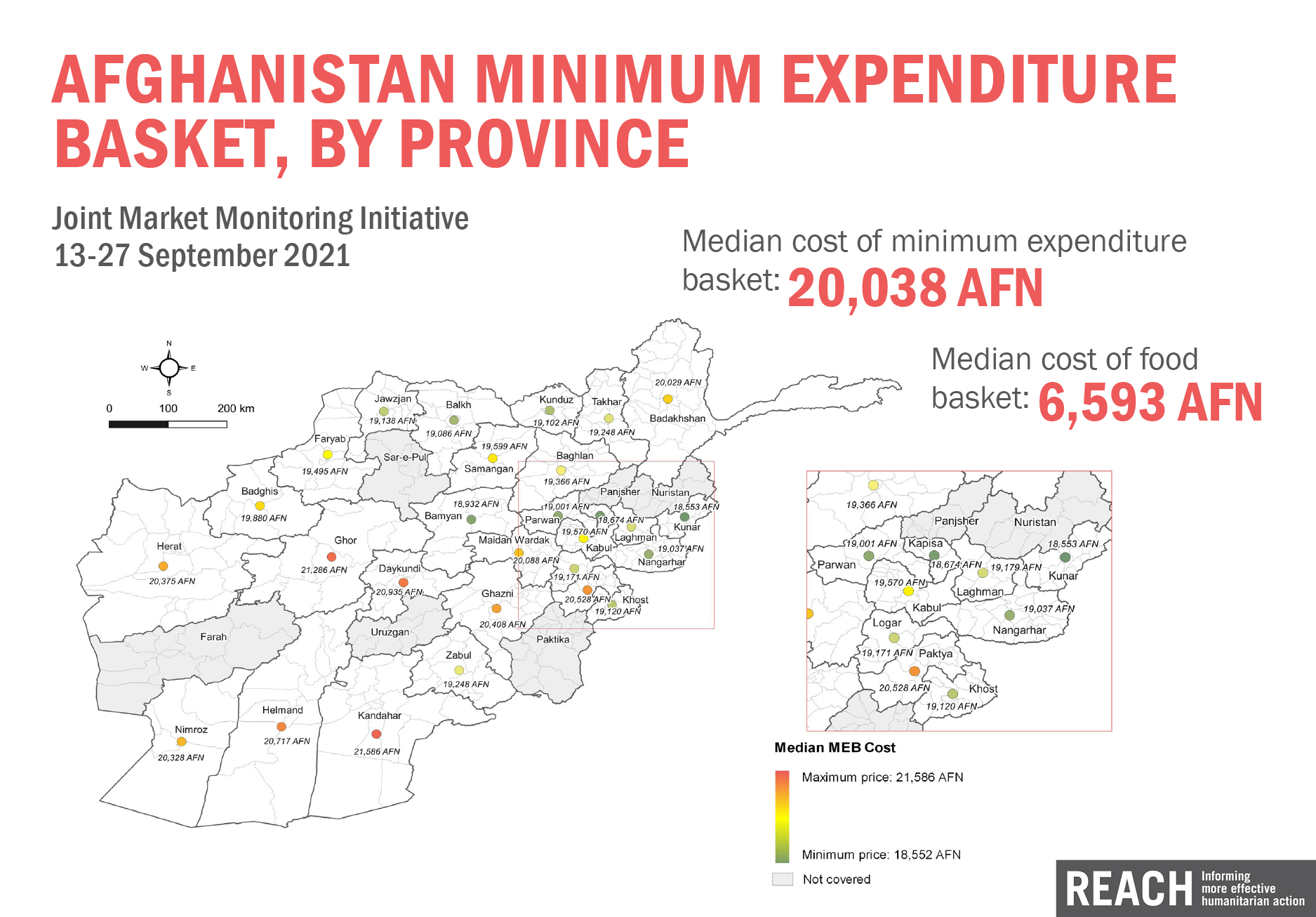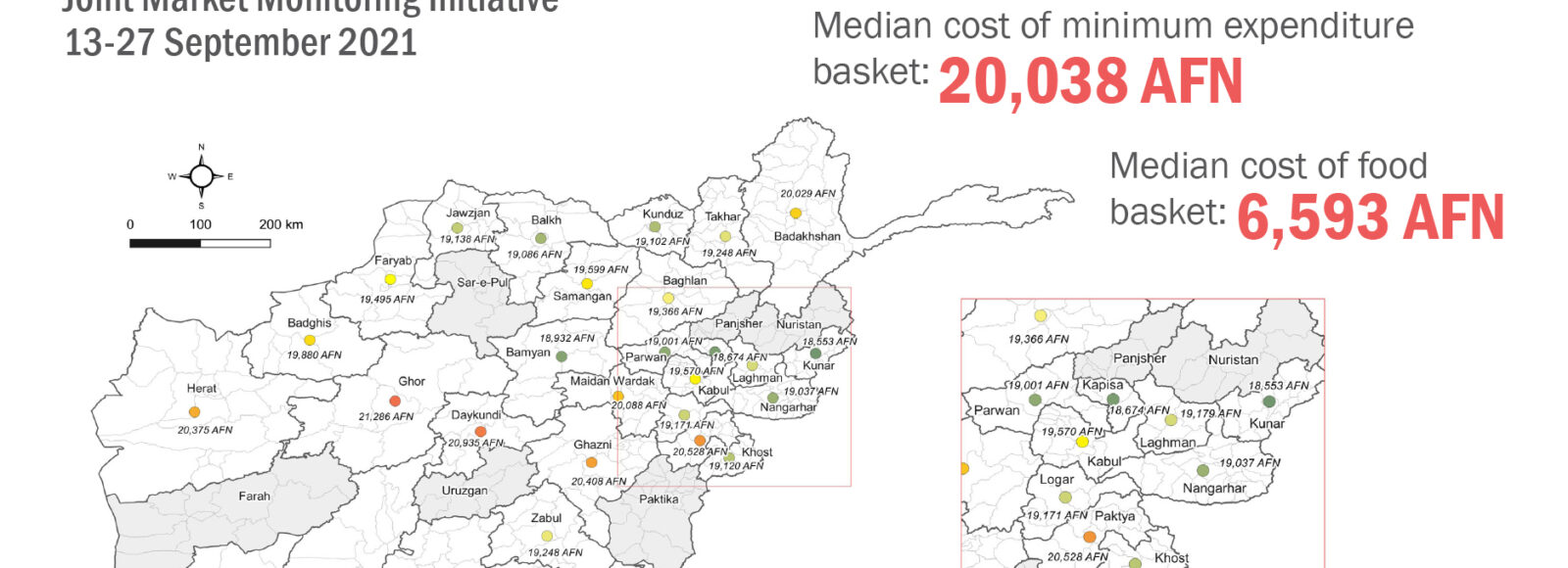Following an offensive that saw the Taliban take control of almost all districts previously held by the government, the Taliban entered the capital Kabul on 15 August and consolidated their power in Afghanistan. More than 409,000 people have been newly internally displaced by the conflict between the Taliban and Government forces and the Taliban’s territorial expansion from May-August. In addition to the escalating violence and political turmoil experienced, Afghanistan has been facing its second drought in four years – spanning across the country, the continued impact of COVID-19, and is now facing a looming economic crisis and key public services at risk of collapse – impacting an already highly fragile economic situation and further perpetuating critical humanitarian needs after already 40 years of conflict and concurrent natural disasters. Never has the need for information to understand the evolving dynamics, magnitude, and severity of humanitarian need in Afghanistan been more prescient.
In this context, REACH is mobilized to shed light on the evolution of needs and notably interviewed 9,880 households & 7,100 key informants between the 4th of August and the 3rd of October 2021. Through this Whole of Afghanistan (WoA) 2021 Assessment, conducted in coordination with OCHA and the Afghanistan ICCT, REACH has been working with the humanitarian community in to share findings since 15 September, to inform HPC milestones as well as a rapid scale-up in response currently in motion.
Assessment findings confirmed that the country now faces a rapidly worsening humanitarian crisis affecting ever-greater numbers in the population. The widespread loss of income, cash shortages, exhausted coping strategies, and rising food costs, coupled with a halt to development assistance, and public services on the brink of collapse, has further exacerbated existing socio-economic vulnerability, manifesting in critical levels of sectoral humanitarian needs.

Assuming a continuation of the status quo, with political and economic instability, insecurity, and humanitarian access all to be closely monitored, WoA Key findings already show:
- Over 90% of households across all assessed populations reported experiencing at least one shock in the past year, affecting greater numbers of populations than in 2020. Most critically, the primary reported impact of any and all shocks was loss of income (72% or greater), highlighting the direct and negative consequences of such shocks on household’s livelihoods, exacerbating pre-existing and chronic levels of poverty and eroded resilience.
- Insufficient livelihoods are leading to even high levels of socio-economic vulnerability and 68% of assessed households reported that they had earned a lower income than usual in the 30 days prior, primarily due to “reduced employment opportunities”.
- Against the backdrop of recent events in Afghanistan, the dynamics and drivers of movement and displacement are anticipated to shift, resulting in new populations of concern, such as ‘IDP returnees’, with indicative estimates that up to 40% of IDPs may return to their Area of Origin in the next months, where they will need further assistance.
- Although intentions to return increased compared to 2020, the vast majority of displaced populations assessed in the WoA still reported an intention to remain in their location of displacement. Consequently, there will be a growth of prolonged and protracted displaced populations in need of a humanitarian response, with many residing in insecure and informal settlements in predominantly urban areas.
- More than half of all households in all assessed population groups reportedly struggled to obtain food or money to buy food and at least a third (37%) were found to have ‘Poor’ Food Consumption Scores (FCS) – a considerable increase from 14% in 2020. This is likely only to worsen as food costs increase in the current economic crisis and with limited availability of cash; the average food basket cost, as tracked by JMMI, was already found to have increased by 16% between June and September 2021.
- Drought affected populations will be of particular concern in 2022, both those already dealing with the impact of drought from 2021 across a third of the country, and continued drought conditions as a result of an anticipated second year of La Niña weather conditions. The WoA found that drought-affected households more frequently reported loss of income (81% compared to 67% non-drought affected), lack of access to food, as well as wider use of emergency coping strategies compared to non-drought affected households (57% compared to 37%)
- Even where availability of services, such as healthcare facilities, was still found to be relatively high (88%), barriers to access and needs also remained considerable (50% of households in need, and 66% reporting barriers). As with many basic services, including education and water infrastructure, with the current political and economic situation creating additional risk of collapse of public services, needs are anticipated to worsen considerably.
- Potential major disease outbreaks –AWD, measles, COVID-19 new wave, etc. will be fought against with reduced primary care capacity and inadequate access to medicine which is already unaffordable for much of the population
- In addition, WoA findings highlighting the reduced socio-economic independence of women suggest greater needs, potential use of more extreme coping strategies, and consequently heightened protection risks, as household resilience is further eroded. Women and girls were found to be further limited in their ability to meet basic needs due to socio-cultural barriers, or fears around safety; half of households (50%) reported that there are areas which women and girls in the household avoid as they feel unsafe. Furthermore, access to services and employment was frequently reported to be predicated on women being accompanied, indicating greater needs for female-headed households.
- Already in 2021, 12% of households reported at least one child working, and 8% of HHs reporting marrying daughters earlier than intended due to a lack of food or money, or having already exhausted this strategy. Whilst the reported prevalence in the overall population did not differ significantly compared to 2020, the increasing exhaustion of already extreme strategies, and the current political and economic climate, raise deep protection concerns for the Afghan population, and particularly women and children, in 2022.
REACH will continue to engage with the community and provide support to planning and implementation, with additional factsheets and reports to follow in the coming weeks and months. Furthermore, in such a dynamic and rapidly evolving context with risk of emergency level needs, REACH is mobilizing to inform a humanitarian situation monitoring system. In addition, given the limitations of collecting data during such a unique period of upheaval and transition, the response also requires a comprehensive re-evaluation. As such REACH will conduct a new Whole of Afghanistan (WoA) assessment early 2022 (Mid-Year WOA 2022).
You can find all datasets and analysis available through the following links on the REACH Resource Centre:
- Household Assessment: Household-level interviews covering all population groups (IDPs, cross-border returnees, and host communities), representative for each population group at national level, and representative for ‘displaced’ and ‘non-displaced’ at provincial level for 22 provinces and indicative for 8 provinces (4 provinces not covered) – dataset and analysis
- Key Informant Assessment: Key Informant Interviews (KIIs) at settlement level in 248 districts across 31 provinces – dataset and analysis
- Dual-Household Interview: Implemented for the second year in 16 provinces, two separate interviews were conducted by mixed-sex enumerator pairs, with one female household member and a male head of household, to allow for comparison of male and female perspectives and needs – dataset and analysis
- ‘Female Voices’: Findings from questions asked specifically to female participants (only interviewed by female enumerators) in select provinces where the dual household interview approach was implements – dataset and analysis
For further information on the methodology, please consult the Terms of Reference, and the Data Analysis Plan and Tool for the Household Survey and the Key Informant Interviews.









